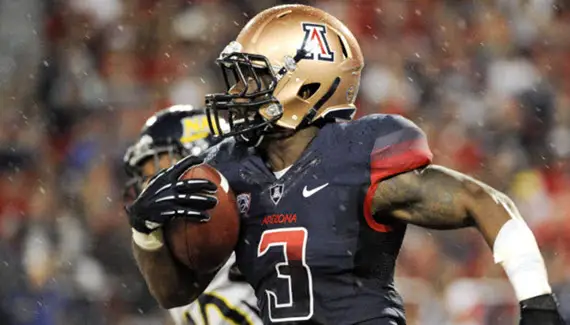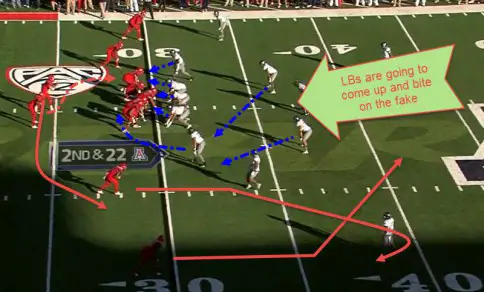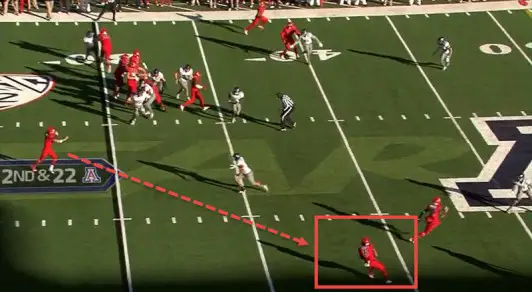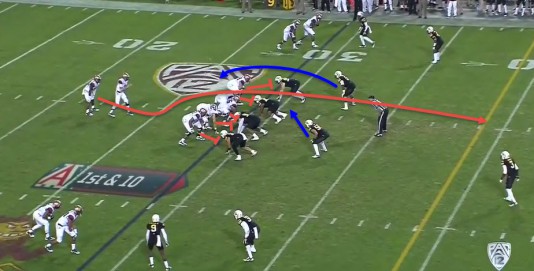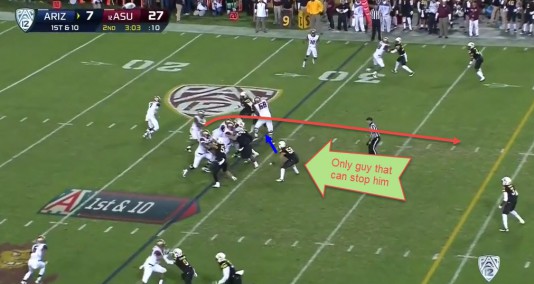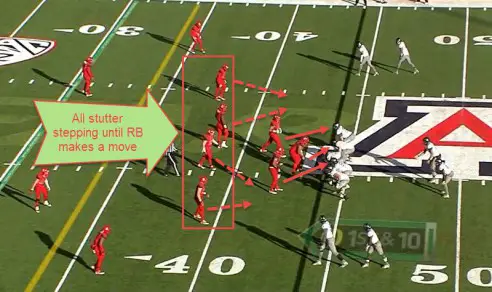Thursday is known as “upset day” in the Pac-12. Be wary of Thursdays! Oregon State shocking No. 1 USC comes to mind. So does Washington surprising No. 8 Stanford in 2012. And, of course, there was Stanford’s takedown of the Ducks last year (sorry for reopening that wound). But these are just a few of the upsets that have occurred on Thursday nights.
This, paired with the fact that Arizona has an extremely potent offense, leads me to pronounce this game, the Upset Warning of the Year for the Ducks. You may recall that ‘Zona obliterated Oregon last year, making them look like a team undeserving of a shot at the Pac-12 title. It’s a different year now, however, as we look back at some footage from last year’s game.
In the screenshot (above) it is 2nd & 22 and the Wildcats are lined up in doubles, with two receivers on both sides of the offensive line. This is going to be a run-pass option play for the quarterback. At the snap, they run a zone read play action to get the defensive line to attack the running back. Now, the linebackers think the quarterback has made the read and kept it, so they immediately go after the quarterback.
Meanwhile, the two receivers on the right side — the side the quarterback is running to — are in single coverage. The two are going to run a post and corner curl route, respectively.
Once the linebackers get within 6-7 yards of the quarterback, the ball is thrown to the open receiver, most often the inside receiver running the corner curl route. The receiver is almost always going to be able to catch the ball and turn, enabling him to gain at least 10 yards (and in this case 17).

Arizona often employs the run-pass option feature of this play in their offense, but the receivers will not always run the same routes. This does not change the fact that the Oregon linebackers cannot blindly rush the quarterback. Instead, they are going to have to be willing to give up 3-4 yard runs in order to prevent Arizona from getting the consistent 10-15 yard gains, as seen in the video above.
Now let’s go to the Territory Cup last year where, on a 1st & 10 late in the 1st half, Arizona ran an Inside Zone on Arizona State, a play often run by our feathered friends and covered by our very own Mr. FishDuck himself a year and a half ago. Again, Arizona is in doubles. Out of this, Arizona (and other spread teams such as Oregon) often runs a bubble screen, so there are only six men in the box.
At the snap, the offensive line is going to run a zone blocking scheme. This play is set up for success against this defense and the fact that the right middle linebacker is blitzing off the edge makes the play that much better. The only player who is going to be able to make a play is the left middle linebacker.
This matchup, though, is unfair. It’s Ka’Deem Carey vs someone who isn’t a Bednarik Trophy candidate. Carey will win this head-to-head challenge nearly every time, and most other quality running backs will win it 60% of the time … good enough for it to be called a successful play.
Arizona’s defense is not on a par with Stanford, but they did successfully neutralize us last year. So, let me show you how they did that. Arizona is going to do something similar to what Michigan State did: create a log jam at the line and force the ball carrier to bounce it outside. at the snap, the linebackers and nickel back are going to stutter step until they are 100% confident that the ball has been handed off, as they don’t want to be beat by Marcus Mariota‘s arm.
The defensive linemen are then going to all go left and take on as many blocks as they can. This closes the hole for the running back and is going to force him to bounce it out. The fact that every defensive lineman is going left and no linebackers are rushing, turns this play into a straight inside zone and the ball is automatically going to the running back.
This means no surprises for Arizona. They know that the running back will be either going right or left, but either way, Arizona has at least two unblocked players to make the tackle.

Given the way Arizona defends the zone read, Oregon should almost always gain at least three yards. That is perfectly fine with ‘Zona as long as Oregon does not break off a big play. To counter this, Oregon is going to have to stick to the passing game and not be deterred if it isn’t working. If they stop throwing, the Wildcats will focus completely on the stopping the run.
Arizona has many weapons, despite the loss of Carey (Heisman and Doak Walker candidate), B.J. Denker (last year’s starting quarterback) and their top two receivers. Austin Hill, arguably the top receiver in the Pac-12, is back after missing all of 2013 with a torn ACL.
Two running backs, Terris Jones-Grigsby and Nick Wilson, have stepped up as potent ball carriers and their new quarterback, redshirt freshman Anu Solomon, has definitely made a name for himself. These are just a few of the new offensive weapons Arizona is going to have tomorrow.
If Arizona’s defense comes to play the way they did last year, making plays such as that memorable tip-drill interception, you can be sure that you will get your money’s worth of excitement. With both teams having byes last Saturday, this will come down to which team makes more plays on defense.
Whoever wins the turnover battle and field position battle will win this game, and because of Arik Armstead and Ifo Ekpre-Olomu, I believe that Oregon will win this game 53-38. This will be the first game at which the U of O students will be there in full force, so expect a rowdy and amped-up crowd.
“Oh how we love to learn about our opponents on FishDuck.com.”
Rory Davidson
Opponent Football Analyst for CFFNetwork/FishDuck.com
Eugene, Oregon
Top photo by footballscoop.com
Related Articles:
Chip Kelly Update: Everything's Good Again ...
Chip Kelly Update: Wailing and Gnashing of Teeth
Shock and Awe -- The Oregon Ducks' Football Hangover Effect
Despite Lopsided Score, Georgia State "Never Stopped Believing"
Hope Springs Eternal for Ducks
Incompetent Pac-12 Officials: How Do You Miss ALL of THIS?
Rory Davidson: Rory (Football Analyst) is a sophomore at Oregon in the fall (Class of 2018). He has been a devout Stanford football fan since he was 2 months old and is excited about the energy and greatness Oregon sports has to offer. For the past 6 years he has been doing advanced data analytics for his high school football team and working alongside the coaches to understand how they strategize about the game. He wants to integrate more statistics into his analyses and try to help readers learn about and understand the future of sports.

